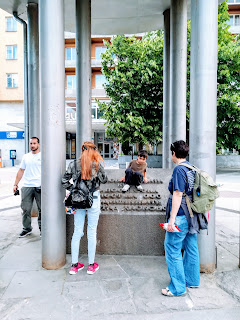"Cities have the capability of providing something for everybody, just because and only when, they are created by everybody" - Jane Jacobs
In our town there are two water towns - one at the most northern place of the Haskovo, and one at its most southern place. Last year
we walked the town from west to east, bu this year our walk crossed it from north to south. So "
The Two Towers" tour was created.
 |
The walk took a little more than two hours. The Google map calculation is incorrect,
because can't reflect the car traffic and the hilly terrain. |
The hills of Haskovo are picturesque, and we were enjoyed our walk. Also we found things that must be improved in terms of walkability and accessibility of urban space in our town. My photo report will be divided in three parts: The North, The Center, and The South of Haskovo.
1. The North.

The group of walkers gather together. From left to right: Eli (architect), Georgi (Eli's husband, a geodesy cartographer), Todor (retired vocational higher school teacher, and coach of the local orienteering team), Simon (mechanical engineer and small business owner), Hristo (artist, trying to hide himself from the camera), Zlatina (history student in Plovdiv), Lydia (Englich language teacher and my girlfriend), and Petar (our son).
Later one more guy joined the group - Sevo (an amateur photographer).
The tower is close to the town, in an industrial area.
There are no people living around.
There are only small factories and stores.
Also the repair base for the city's fire trucks is this area.
A factory.
One of the electricity stations in the town.
This was the first water tower in the northern part of the town. Now it is not used.
In the communist period, this building was a factory, where the deaf people worked.
Finally we entered the inhabited areas of the northern part. It is interesting - on the right side of the main road there are only houses. On the left side of the main road there are large apartment blocks.
And this is a trade center. Can you imagine: it is owned by Chinese people. Even in Haskovo now there are Chinese. The migration nowadays in not only on the borders of the state (as it was during the communism), or from Bulgaria to the west (as it was in the last 25+ years after the communism). Now there is one more route - from Asia to Bulgaria, and what is impressing, is that few Chinese families came to live here, not in the bigger cities of the country.
Some of the big apartment block on the other side of the main road.
Nice small public space at front of a small residential building.
2. The Center.
Slowly we reached the center. Some of us did not know that at this place there is a monument if the Bulgarian revolutionary Petar Berkovski.
The architect among us - Eli, said that each monument needs some open space around,
otherwise it will remain invisible, and will be lost in the urban body.
An administrative building from the 1970s.
I shared with the others the story of this clock tower. Long story short - on the same place in the early 19th century was built a stone tower. For unknown reason it was destroyed in the beginning of the 20th century. In the 1980s, when the local historians ecided that our town is 1000-year old, the local authororities decided to build a new clock tower at the place of the old one. I love this tower very much for its interesting design. It is high, but because it is not monolithic and it's made from columns, there is some etherealness and lightness in it. The construction does not "weigh" in space.

The concept of continuity is presented by the fact, that the architects choose to build the tower at the same place, where the old stone tower was built. The stone scripture says that it is dedicated to the millennium anniversary of Haskovo.
This is the Monument of Envy.
It is the only monument, presenting this bad human characteristic.
One of the many nice buildings in the city center. There buil in the first half of the 20th century.
3. The south.
We walk one of the most important arterial roads in the town - it's called blvd."Osvobozhdenie" (in Bulgarian this means "Liberation"), but the locals call it simple "Kardzhaliyska" street, because it goes to the next big town in the south - Karzdali.
We are in "Hisarya" neighborhood. In Turkish "hisar" means a fortress (compare with
Hisarlik of Trow). This place is called so fr reason - in this area was the medieval fortress of Haskovo.
View to the center and the north of the town.
Finally we reached the southern Water tower of Haskovo.
Local residents have built (probably illegal) farm buildings in which they are raising animals.
The photographer Sevo took this photo of our group. On my tight shoulder you might notice the northern tower. We were there just two hours ago, we crossed the town, and finally we completed the walk on the towns southern side. Then we visited the ruins of the medieval fortress of Haskovo. Meanwhile, heavy rain fell upon us.
But the rain did not stop us. Happily, it was a spring rain, which continues for about a twenty minutes, and soon stopped.
We went back to the town's center. It was a pleasant time.
And then a rainbow appeared in the sky.



















































